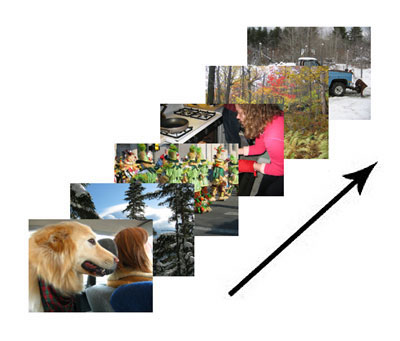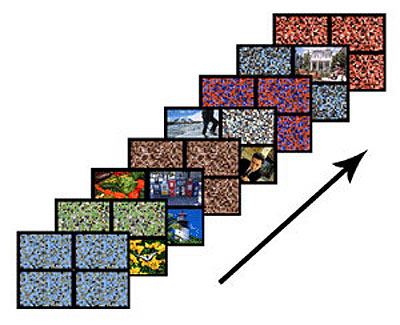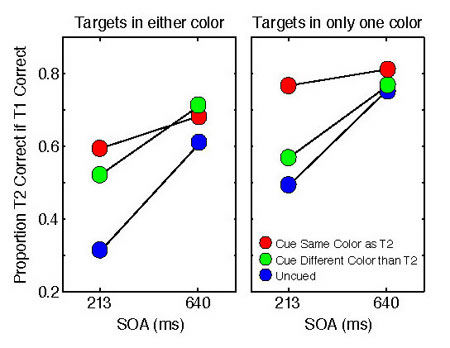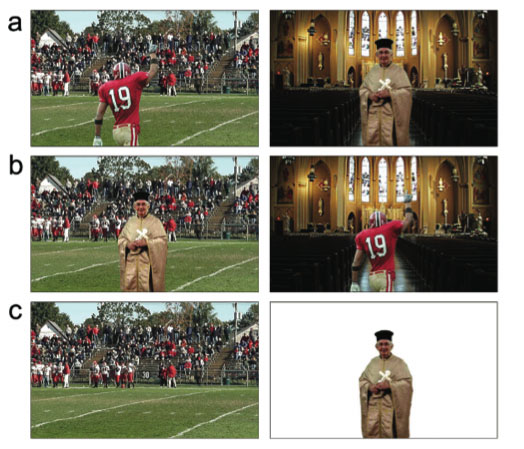Research
Research
1. Short term picture comprehension and memory
2. Attention in search tasks: The Attentional Blink
3. Detecting words in two streams at high rates
4. Comprehension of an object and its background
5. Conceptual short term memory (CSTM)
1. Short term picture comprehension and memory
When participants view an RSVP of pictures at about six pictures per second, they cannot remember many of them when their memory is tested right afterward (see the first demo). But when told what to look for, viewers can detect a picture of "a picnic" or "a woman on the phone" within a rapid sequence of pictures (see the second and third demos.
In recent work using extremely rapid sequences (down to 13 ms per picture) we have shown above-chance detection not only when the target name is given just before the sequence, but also when it is given immediately after the sequence.
[Click here for related publications]
|
Demo 1: Memory for rapid pictures You will see a short rapid serial visual presentation (RSVP) of pictures (about 6 pictures per second), |
|
Demo 2: Detecting a named picture You will see another RSVP sequence of pictures: look for a MOOSE. This should be easy. |
|
Demo 3: More rapid pictures Again, easy to see and remember, when you know what you are looking for. |
|
Demo 4: Reading sentences and word strings People can read and remember sentences presented at 10 or 12 words per second, but not scrambled sentences. |
|
Demo 5: Reading a paragraph It helps to know what you are reading about (Potter, Kroll, & Harris, 1980). |
People can detect a target picture within rapid sequences where up to four pictures are presented on a frame, but they consolidate memory for pictures presented in such sequences more slowly, one at a time (Potter & Fox, 2009).
2. Attention in search tasks: The Attentional Blink
When the viewer is looking for two targets in a sequence of non-targets presented at a rate of 10/s, detection of the second target is markedly impaired when it arrives 200-500 ms after the first target, an "attentional blink." We have studied this effect in RSVP sequences of letters among digits and more recently in word targets (e.g,, 'animal') among other words and words in sentences, contrasting the effect of looking for a target with whole report of the sequence. [Click here for related publications]
3. Detecting words in two streams at high rates
We have also done work with word targets presented among number and symbol strings, extending the attentional blink procedure described above to rates of 19 items/s and using two simultaneously presented sequences of stimuli, with one target in each stream that appear either simultaneously or at varying SOAs. Interestingly, at very short intervals between targets (such as 53 ms), the second target is actually more likely to be seen than the first target. At longer intervals, we obtain the familiar attentional blink pattern in which the first target is more likely to be seen. In further studies with this task we have found substantial effects of semantic priming. [Click here for related publications]
4. Comprehension of an object and its background
Jodi Davenport, then a graduate student in the lab, studied the interaction between a foreground object and its background, in colored photographs presented very briefly and masked. When the background and object are mutually consistent (e.g., a football player on a football field), both the report of the object and the report of the background are more accurate, as compared to when they are inconsistent (e.g., a football player in a church). Further work examined scenes with multiple foreground objects. [Click here for related publications]
5. Conceptual short term memory
The lab's work also encompasses other questions about perception, attention, memory, and language processing, including repetition blindness [click here for related publications], comparative processing of words and pictures of the objects [click here for related publications], the creative misperception of a nonword as influenced by semantic context, cross-modal (visual-auditory) processing of sentences, and the conceptual basis of "verbatim" recall of sentences. For example, the lab has shown that a 14-word sentence can be understood and remembered when presented as rapidly as 12 words per second. In contrast, a sequence of unrelated words (even if no more than 4 or 5 words long) is much more difficult to process and few words are remembered.
These studies contribute to our understanding of how a stimulus such as a word, sentence, or picture quickly generates an interpretation and a fleeting or stable memory. They flesh out the evidence that, early in processing, multiple associations are briefly activated and used selectively to generate a stable interpretation of ongoing experience. There is rapid forgetting of irrelevant associations and of stimuli that do not fit the best interpretation (the viewer may not even become conscious of a stimulus unless it fits with the interpretation). We have termed this process conceptual short term memory (CSTM). [Click here for related publications]





